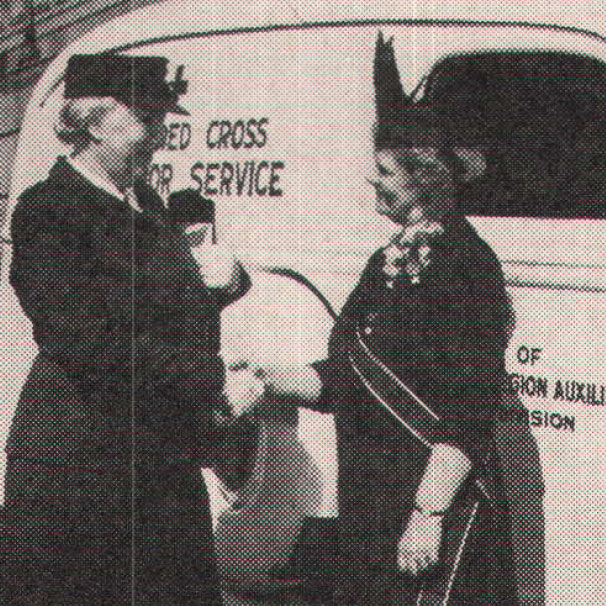
By Cathi Taylor, ALA National Headquarters Archivist
June 6 marked the 80th anniversary of D-Day, the first day in the Normandy Campaign of World War II. News coverage of this anniversary reminded me how entrenched the American Legion Auxiliary was in the war effort, particularly with the American Red Cross.
But this relationship didn’t develop until after Pearl Harbor. Europe had already been at war for two years, and the United States government was staying out of it. What was The American Legion saying?
At its 1939 National Convention, the Legion passed two resolutions. One allowed for “practicable aid” only being given to Great Britain and those aligned with her but to remain militarily neutral. The other one stated that no department and no post could participate officially in campaigning for funds or provide material relief to any foreign nation involved in the war. In other words, we could give aid but only as individuals, not as an organization. The Auxiliary’s hands were tied. Or were they?
 Sometimes we’re required to think outside the box and that is exactly the tactic that Auxiliary member Enid Lemstra of Clinton, Ind., took. Having worked with the American Red Cross during World War I, as national president (1940-1941) she rekindled that relationship. At the November Department Presidents and Secretaries Conference, Lemstra announced the collaboration. By sending aid packages through the Red Cross, there was a much greater guarantee they would arrive in Great Britain.
Sometimes we’re required to think outside the box and that is exactly the tactic that Auxiliary member Enid Lemstra of Clinton, Ind., took. Having worked with the American Red Cross during World War I, as national president (1940-1941) she rekindled that relationship. At the November Department Presidents and Secretaries Conference, Lemstra announced the collaboration. By sending aid packages through the Red Cross, there was a much greater guarantee they would arrive in Great Britain.
And so, the relationship began under the auspices of a new national committee — the Emergency Voluntary Service Committee. First came disaster relief. Auxiliary members were instructed in canteen service, first aid, stretcher service, and motor repair. Training was offered in nurse aides, family case work, recreational work, secretarial work, and household service as well as production work, which is where most of the women went. They made clothes, knitted items, and made bandages and surgical dressings. By the 1941 National Convention, Auxiliary units began taking over the entire responsibility of local Red Cross workrooms, working more than 1 million hours for the Red Cross alone!
It was at that same convention that more work needed to be done. Minnie Harmon, assistant director of volunteer service of the American Red Cross, announced the Army and Navy were looking to the organization to supply both liquid and dried blood plasma, a request that would require 400,000 donors. The Red Cross needed the Auxiliary to find these donors. However, that need quickly increased after the attack on Pearl Harbor three months later.
 The relationship continued throughout the remaining war years. The Auxiliary national organization —immediately following the declaration of war — purchased a mobile hospital unit for the Red Cross at a price of $1,400. By the 1942 National Convention, Auxiliary members raised enough money for five more units.
The relationship continued throughout the remaining war years. The Auxiliary national organization —immediately following the declaration of war — purchased a mobile hospital unit for the Red Cross at a price of $1,400. By the 1942 National Convention, Auxiliary members raised enough money for five more units.
Then our attention was turned to recruiting 100,000 nurse aides. By 1944, the American Red Cross was in desperate need of clubmobiles, mobile service vehicles that provided servicemen and women with food, entertainment, and that all-important connection to home. The Auxiliary members came through with enough money to purchase two of them, at a total cost of $42,000.
The relationship continued through the remaining days of the war and afterward as the need for blood plasma, nurse aides, and nurses continued. It was a relationship that continued into the 1960s.
As an ALA member, I don’t hear anything about the Auxiliary working with the Red Cross, but, like most organizations, the Red Cross needs volunteers. If you can’t volunteer, there’s still a critical need for blood.
The American Red Cross and the Auxiliary have been a part of each other since before the formation of the ALA — whether as doughnut girls or Red Cross nurses during the Great War. Each organization touches many lives. Just think how many more lives we could touch if we worked together like we did during World War II.
ALA Digital Archive Collection
To learn more about the history of the American Legion Auxiliary, please visit our digital archive collection at https://alaforveterans.pastperfectonline.com.